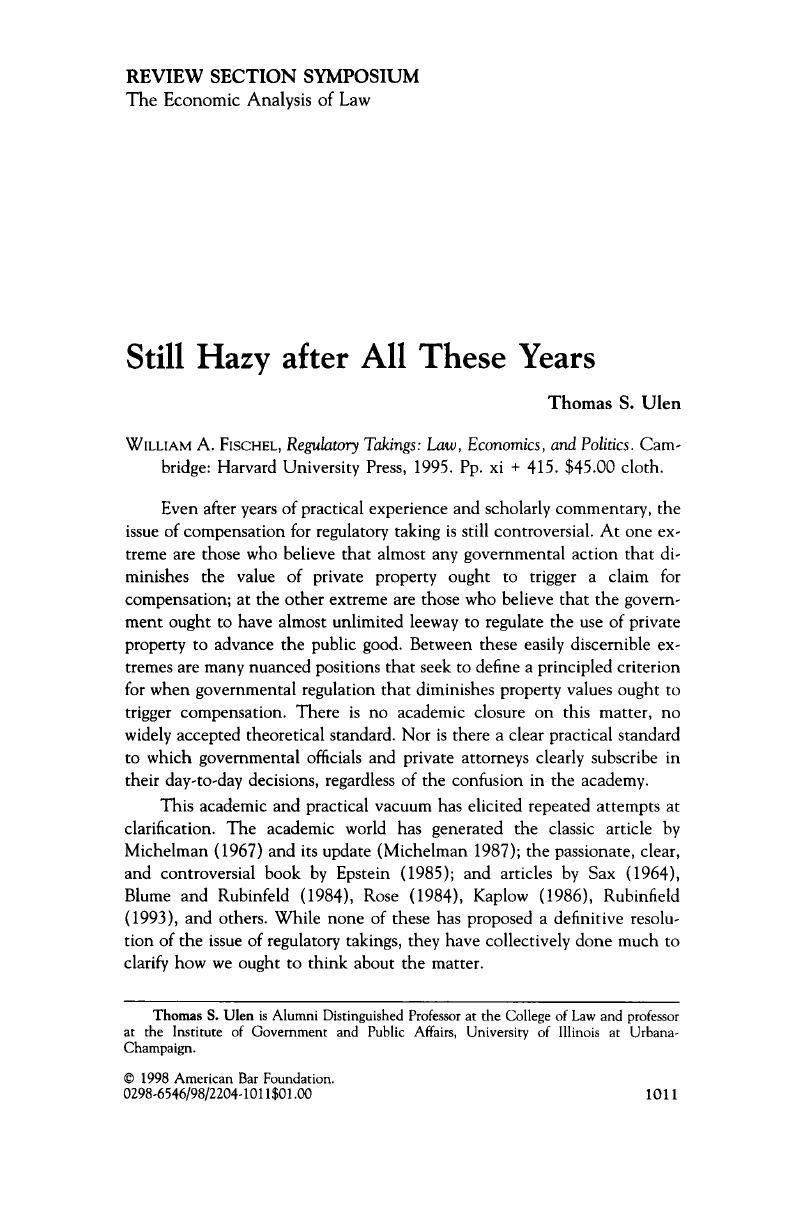No CrossRef data available.
Article contents
Still Hazy after All These Years
Published online by Cambridge University Press: 27 December 2018
Abstract
An abstract is not available for this content so a preview has been provided. Please use the Get access link above for information on how to access this content.

- Type
- Review Section Symposium
- Information
- Copyright
- Copyright © American Bar Foundation, 1997
References
Alexander, Gregory S.
1996. Ten Years of Takings. Journal of Legal Education
46: 586–95.Google Scholar
Blume, Lawrence E., and Rubinfeld, Daniel L.
1984. Compensation for Takings: An Economic Analysis. California Law Review
72: 569–628.Google Scholar
Calabresi, Guido, and Melamed., A. Douglas
1972. Property Rules, Liability Rules, and Inalienability: One View of the Cathedral. Harvard Law Review
85: 1089–1128.Google Scholar
Coase, Ronald A.
1960. The Problem of Social Cost. Journal of Law and Economics
3: 1–44.Google Scholar
Cooter, Robert D.
1985. Unity in Tort, Contract, and Property: The Model of Precaution. California Law Review
73: 1–51.Google Scholar
Cooter, Robert D., and Ulen, Thomas S.
1997. Law and Economics. Reading, Mass.: Addison Wesley Longman.Google Scholar
Ellickson, Robert C.
1986. Of Coase and Cattle: Dispute Resolution among Neighbors in Shasta County. Stanford Law Review
38: 623–87.Google Scholar
Ellickson, Robert C.
1996. Takings Legislation: A Comment. Harvard Journal of Law and Public Policy
20: 75–84.Google Scholar
Ely, John Hart. 1980. Democracy and Distrust: A Theory of Judicial Review. Cambridge: Harvard University Press.Google Scholar
Ely, John Hart. 1991. Another Such Victory: Constitutional Theory and Practice in a World Where Courts Are No Different from Legislatures. Virginia Law Review
77: 833–79.Google Scholar
Epstein, Richard A.
1985. Takings: Private Property and the Power of Eminent Domain. Cambridge: Harvard University Press.Google Scholar
Kaplow, Louis. 1986. An Economic Analysis of Legal Transitions. Harvard Law Review
99: 509–617.Google Scholar
Korobkin, Russell. 1995. Policymaking and the Offer/Asking Price Gap: Toward a Theory of Efficient Entitlement Allocation. Stanford Law Review
46: 663–708.Google Scholar
Levmore, Saul. 1990. Just Compensation and Just Politics. Connecticut Law Review
22: 285–322.Google Scholar
Michelman, Frank I.
1967. Property, Utility, and Fairness: Comments on the Ethical Foundations of “Just Compensation” Law. Harvard Law Review
80: 1165–1258.Google Scholar
Rachlinski, Jeffrey. 1997. Gains, Losses, and the Psychology of Litigation. Southern Califomia Law Review
70: 113–85.Google Scholar
Rose, Carol M.
1984. Mohan Reconsidered: Why the Takings Issue Is Still a Muddle. Southern California Law Review
57: 561–99.Google Scholar
Sunstein, Cass. 1997. Analysis of Law. Working paper no. 46 (2d ser.), John M. Olin Progra. In Law and Economics, University of Chicago.Google Scholar


